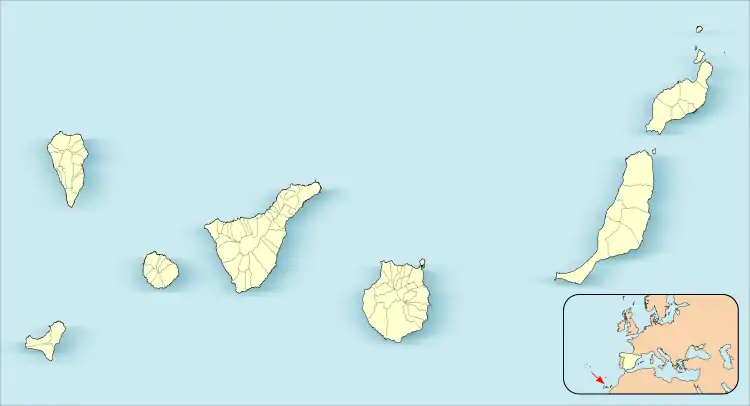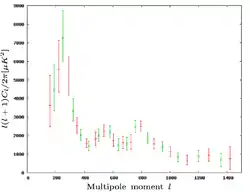 The VSA ground shields | |
| Part of | Teide Observatory |
|---|---|
| Location(s) | Tenerife, Atlantic Ocean, international waters |
| Coordinates | 28°18′02″N 16°30′37″W / 28.30064°N 16.51028°W |
| Organization | Cavendish Astrophysics Group Instituto de Astrofísica de Canarias Jodrell Bank Observatory University of Cambridge |
| Altitude | 2,500 m (8,200 ft) |
| Wavelength | 0.83 cm (36 GHz)–1.2 cm (25 GHz) |
| Telescope style | radio interferometer |
| Angular resolution | 0.2 degree |
| Website | www |
 Location of Very Small Array | |
| | |
The Very Small Array (VSA) was a 14-element interferometric radio telescope operating between 26 and 36 GHz that is used to study the cosmic microwave background radiation. It was a collaboration between the University of Cambridge, University of Manchester and the Instituto de Astrofisica de Canarias (Tenerife), and was located at the Observatorio del Teide on Tenerife. The array was built at the Mullard Radio Astronomy Observatory by the Cavendish Astrophysics Group and Jodrell Bank Observatory, and was funded by PPARC (now STFC). The design was strongly based on the Cosmic Anisotropy Telescope.[1][2]
The telescope was comparable in terms of capabilities to several other CMB experiments, including the balloon-based BOOMERanG and MAXIMA, and the ground-based DASI and CBI.[3]
Design

The telescope consists of 14 elements (yielding 91 baselines), each of which have a horn reflector antenna focusing astrophysical signals into individual receivers (pseudomorphic HFET amplifiers, with a system temperature around 25 K and a physical temperature of 12 K,[1] based on an NRAO design).[4] The separate elements are combined using a correlator to form an aperture synthesis array.[4] The elements are mounted on a tip-table, which is capable of tracking the sky and can tilt up to 35 degrees from the zenith.[1]
The telescope has been used in three different configurations – "compact", "extended" and "super-extended", each of which differ in the separation distance between the elements (the difference between compact and extended is a factor of 2.25), and the size of the antennas.[1] While the compact array has antennas 143 mm in diameter, the extended array uses 322 mm diameter antennas.[5] This means that the compact array has a primary beam of 4.5 degrees, and a resolution of 30 arcminutes (multipoles between 100 and 800), while the extended array has a primary beam of 2 degrees, a resolution of 12 arcminutes and can hence observe multipoles between 250 and 1500.[6] The extended array is also a factor of 5 more sensitive than the compact array.[5] The super-extended array will be able to measure multipoles up to 3000,[7] and has 550 mm antenna mirrors. The front-end amplifiers were also upgraded.[8]
The telescope can be tuned to frequencies between 26 and 36 GHz, with 1.5 GHz bandwidth, meaning that the telescope can carry out observations at different frequencies.[9]
It also includes two 3.7 m radio telescopes, also working at 30 GHz,[10] which are dedicated to monitoring foreground sources.[3] These source subtraction dishes were upgraded to more accurate ones following the first series of observations, to allow the monitoring of much weaker sources than previously.[5]
Both the source subtractor dishes, and the VSA itself, are surrounded by large metal ground shields.[2]
As the VSA is an interferometer, it directly measures the angular power spectrum of the CMB, rather than having to construct a map of the sky first.[2][11]
Results

The fields observed with the VSA were chosen to minimize the amount of bright radio sources and large clusters in the field (the latter to avoid the Sunyaev-Zel'dovich effect), as well as to avoid contamination by emission from our galaxy.[7] The radio point sources present in the VSA fields were observed with the Ryle Telescope at 15 GHz, then monitored by the VSA source subtracters during the VSA observations.[3]
In the compact array configuration, the telescope observed three 7×7 degree areas of the sky to high precision[1] in an observing session between August 2000 and August 2001.[12] These observations were taken at the highest frequency of the telescope, centered at 34 GHz, to reduce foreground contamination.[9] Another, larger area of the sky was also observed, but less precisely.[9] The data from these observations were reduced independently at all three involved institutions.[4] The results from these observations were published in a series of four papers in 2003; those by Watson et al., Taylor et al., Scott et al. and Rubino-Martin et al. (see References below). The key results were the power spectra of the Cosmic Microwave Background between multipoles of 150 and 900,[11] and the resulting limits on cosmological parameters when combined with data from observations from other experiments.[13]
The second observing session ran between September 2001[12] and July 2003, and was using the extended array.[14] The first results from the extended array were published as a Letter in 2003, simultaneously with the first four publications, using data taken up until April 2002. The sections of the sky observed were located within the previously-observed fields, with the measurements being both more accurate and in greater detail. The result was an improved power spectrum of the CMB, going out to a multipole of 1400,[5] and refined cosmological parameters.[15] The second set of results were published in 2004, and consisted of the original observations plus more observations taken in the same regions of the sky, as well as observations in three new regions. This yielded measurements of the CMB power spectra out to l of 1500 much more accurately than previously,[7] and more accurate cosmological parameter estimates.[16]
Observations with the VSA continued until the end of August 2008, using the Super-Extended configuration. Also, the Ryle Telescope has been upgraded to detect lower flux point sources, and the OCRA receiver on a telescope in Poland will be used to more accurately subtract the point sources.[8]
 |
 |
 |
| The Very Small Array's measurements of the CMB power spectra. From left to right: from first observations,[11] the first results from the second observing session[5] and the final results from the second observing session.[7] | ||
See also
References
- 1 2 3 4 5 "University of Cambridge webpage on the VSA". Retrieved 23 June 2007.
- 1 2 3 "Jodrell Bank webpage on the VSA". Retrieved 23 June 2007.
- 1 2 3 Watson, R. A.; et al. (2003). "First results from the Very Small Array I: Observational Methods". MNRAS. 341 (4): 1057–1065. arXiv:astro-ph/0205378. Bibcode:2003MNRAS.341.1057W. doi:10.1046/j.1365-8711.2003.06338.x. S2CID 17592336.
- 1 2 3 "Jodrell Bank Observatory - VSA Receivers". Retrieved 23 June 2007.
- 1 2 3 4 5 Grainge, Keith; et al. (2003). "The CMB Power Spectrum out to l = 1400 measured by the VSA". MNRAS. 341 (4): L23–L28. arXiv:astro-ph/0212495. Bibcode:2003MNRAS.341L..23G. doi:10.1046/j.1365-8711.2003.06563.x.
- ↑ "Technical specifications of the VSA". Jodrell Bank Observatory. Retrieved 23 June 2007.
- 1 2 3 4 Dickinson, Clive; et al. (2004). "High sensitivity measurements of the CMB power spectrum with the extended Very Small Array". MNRAS. 353 (3): 732. arXiv:astro-ph/0402498. Bibcode:2004MNRAS.353..732D. doi:10.1111/j.1365-2966.2004.08206.x. S2CID 2806871.
- 1 2 Cleary, Kieran; Taylor, Angela C.; Waldram, Elizabeth; Battye, Richard A.; Dickinson, Clive; Davies, Rod D.; Davis, Richard J.; Genova-Santos, Ricardo; et al. (2005). "Source subtraction for the extended Very Small Array and 33-GHz source count estimates". MNRAS. 360 (1): 340–353. arXiv:astro-ph/0412605. Bibcode:2005MNRAS.360..340C. doi:10.1111/j.1365-2966.2005.09037.x. S2CID 10370174.
- 1 2 3 Taylor, Angela C.; et al. (2003). "First Results From The Very Small Array II: Observations of the CMB". MNRAS. 341 (4): 1066–1075. arXiv:astro-ph/0205381. Bibcode:2003MNRAS.341.1066T. doi:10.1046/j.1365-8711.2003.06493.x. S2CID 15605923.
- ↑ "VSA Source Subtractors". Jodrell Bank Observatory. Retrieved 23 June 2007.
- 1 2 3 Scott, P. F.; et al. (2003). "First results from the Very Small Array III: The CMB Power Spectrum". MNRAS. 341 (4): 1076–1083. arXiv:astro-ph/0205380. Bibcode:2003MNRAS.341.1076S. doi:10.1046/j.1365-8711.2003.06354.x. S2CID 119088948.
- 1 2 Maisinger, Klaus; Hobson, M. P.; Saunders, Richard D. E.; Grainge, Keith J. B. (2003). "Maximum-likelihood astrometric geometry calibration of interferometric telescopes: application to the Very Small Array". MNRAS (abstract). 345 (3): 800–808. arXiv:astro-ph/0212210. Bibcode:2003MNRAS.345..800M. doi:10.1046/j.1365-8711.2003.06995.x. S2CID 11987021.
- ↑ Rubino-Martin, J. A.; et al. (2003). "First results from the Very Small Array IV: Cosmological Parameter Estimation". MNRAS. 341 (4): 1084–1092. arXiv:astro-ph/0205367. Bibcode:2003MNRAS.341.1084R. doi:10.1046/j.1365-8711.2003.06494.x. S2CID 18192370.
- ↑ "VSA Extended Array Power Spectrum Data". Retrieved 23 June 2007.
- ↑ Slosar, Anze; et al. (2003). "Cosmological Parameter Estimation and Bayesian model comparison using VSA data". MNRAS. 341 (4): L29–L34. arXiv:astro-ph/0212497. Bibcode:2003MNRAS.341L..29S. doi:10.1046/j.1365-8711.2003.06564.x. S2CID 12420402.
- ↑ Rebolo, Rafael; et al. (2004). "Cosmological parameter estimation using Very Small Array data out to l=1500". MNRAS. 353 (3): 747–759. arXiv:astro-ph/0402466. Bibcode:2004MNRAS.353..747R. doi:10.1111/j.1365-2966.2004.08102.x. S2CID 13971059.
Further reading
- Savage, Richard; Battye, Richard A.; Carreira, Pedro; Cleary, Kieran; Davies, Rod D.; Davis, Richard J.; Dickinson, Clive; Genova-Santos, Ricardo; et al. (2004). "Searching for non-Gaussianity in the Very Small Array data". MNRAS. 349 (3): 973–982. arXiv:astro-ph/0308266. Bibcode:2004MNRAS.349..973S. doi:10.1111/j.1365-2966.2004.07578.x. S2CID 16877915.
- Smith, Sarah; et al. (2004). "Estimating the bispectrum of the Very Small Array data". MNRAS. 352 (3): 887–902. arXiv:astro-ph/0401618. Bibcode:2004MNRAS.352..887S. doi:10.1111/j.1365-2966.2004.07885.x. S2CID 14172358.
- Lancaster, Katy; Genova-Santos, Ricardo; Falcon, Nelson; Grainge, Keith; Gutierrez, Carlos; Kneissl, Rudiger; Marshall, Phil; Pooley, Guy; et al. (2005). "Very Small Array observations of the Sunyaev-Zel'dovich effect in nearby galaxy clusters". MNRAS. 359 (1): 16–30. arXiv:astro-ph/0405582. Bibcode:2005MNRAS.359...16L. doi:10.1111/j.1365-2966.2005.08696.x. S2CID 14038645.
- Génova-Santos, Ricardo; et al. (2005). "A Very Small Array search for the extended Sunyaev-Zel'dovich effect in the Corona Borealis supercluster". MNRAS. 363 (1): 79–92. arXiv:astro-ph/0507285. Bibcode:2005MNRAS.363...79G. doi:10.1111/j.1365-2966.2005.09405.x. S2CID 16018448.
- Rajguru, Nutan; et al. (2005). "Cosmic microwave background observations from the Cosmic Background Imager and Very Small Array: a comparison of coincident maps and parameter estimation methods" (PDF). MNRAS. 363 (4): 1125–1135. arXiv:astro-ph/0502330. Bibcode:2005MNRAS.363.1125R. doi:10.1111/j.1365-2966.2005.09519.x. S2CID 118112483.
- Rubiño-Martín, José Alberto; Aliaga, Antonio M.; Barreiro, R. B.; Battye, Richard A.; Carreira, Pedro; Cleary, Kieran; Davies, Rod D.; Davis, Richard J.; et al. (2006). "Non-Gaussianity in the Very Small Array cosmic microwave background maps with smooth goodness-of-fit tests". MNRAS. 369 (2): 909–920. arXiv:astro-ph/0604070. Bibcode:2006MNRAS.369..909R. doi:10.1111/j.1365-2966.2006.10341.x. S2CID 55713539.